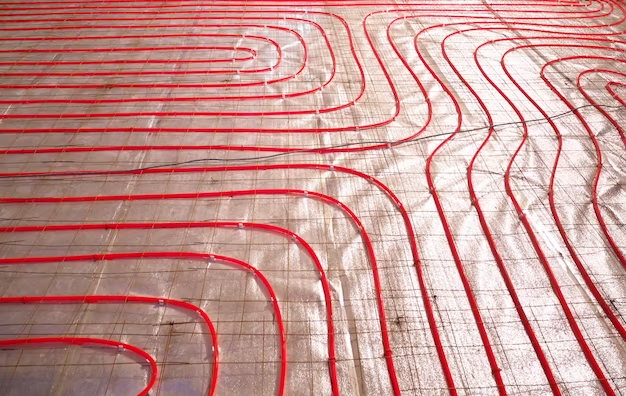The complete guide to Radiant Floor Heating
The complete guide to Radiant Floor Heating
Radiant floor heating is a heating system that is installed
beneath the floor of a building. The system heats the space by emitting thermal
radiation from the floor, which warms up the people and objects in the room.
This is in contrast to forced-air heating systems, which use heated air to warm
up a space. Radiant floor heating systems typically consist of a network of
pipes or electric heating elements that are embedded in the floor, either in a
concrete slab or under a layer of flooring material. The heat source can be a
boiler, a heat pump, or an electric heating element, depending on the type of
system.
There are two main types of radiant floor heating systems:
hydronic and electric
Hydronic
Radiant Floor Heating
Hydronic radiant floor heating is a popular and efficient
heating system that uses hot water to heat the floor, which then radiates heat
into the room. Unlike traditional heating systems that rely on forced air,
hydronic radiant floor heating provides even, comfortable heating without any
noise or drafts. In this blog, we'll cover everything you need to know about
hydronic radiant floor heating.
How
Hydronic Radiant Floor Heating Works
Hydronic radiant floor heating works by circulating hot
water through pipes installed underneath the floor. The hot water heats up the
floor, which then radiates heat into the room. The water is heated by a boiler,
which can run on natural gas, propane, or electricity. The temperature of the
water is controlled by a thermostat, which can be programmed to maintain a comfortable
temperature throughout the day.
Installation
Process
The installation process for hydronic radiant floor heating
can be complex and should be done by a professional. Here are the basic steps
involved:
Plan the layout: Work with a professional to
determine the best layout for your radiant floor heating system. This will
depend on the size and shape of your room, as well as the location of your
heating system.
Install the insulation: Insulation is important to
prevent heat loss and to ensure that the heat is directed upwards into the
room. Install insulation under the subfloor or between the joists, depending on
your specific system.
Install the heating system: Hydronic radiant floor
heating systems use pipes to circulate hot water. The pipes are installed in a
serpentine pattern, with each loop connected to the boiler.
Connect the system to the boiler: The heating system
is connected to the boiler, which heats up the water and circulates it through
the pipes.
Install the flooring: Once the heating system is in
place, you can install your chosen flooring material on top. Make sure to use a
flooring material that is compatible with your heating system.
Test the system: After installation, test your
radiant floor heating system to make sure it is working properly. You may need
to adjust the temperature or make other adjustments to ensure optimal
performance.
Electric Radiant Floor Heating
Electric radiant floor heating is a type of heating system
that uses electric cables or mats installed under the floor to heat a room. It
is an efficient and cost-effective way to provide comfortable heating,
especially in areas with cold winters. In this blog, we'll explore everything
you need to know about electric radiant floor heating.
How
Electric Radiant Floor Heating Works
Electric radiant floor heating works by using cables or mats
that are installed under the floor. When electricity is passed through the
cables or mats, they heat up, and that heat is then transferred to the floor,
which then radiates heat into the room. The temperature is controlled by a
thermostat, which can be programmed to maintain a comfortable temperature
throughout the day.
Installation
Process
The installation process for electric radiant floor heating
is relatively straightforward and can be done by a professional or DIY if you
have some experience with electrical work. Here are the basic steps involved:
Plan the layout: Determine the best layout for your
electric radiant floor heating system. This will depend on the size and shape
of your room, as well as the location of your heating system.
Install the insulation: Insulation is important to
prevent heat loss and to ensure that the heat is directed upwards into the
room. Install insulation under the subfloor or between the joists, depending on
your specific system.
Install the heating system: Electric radiant floor
heating systems use cables or mats to heat the floor. The cables or mats are
installed in a serpentine pattern, with each loop connected to the thermostat.
Connect the system to the thermostat: The heating
system is connected to the thermostat, which controls the temperature and can
be programmed to maintain a comfortable temperature throughout the day.
Install the flooring: Once the heating system is in
place, you can install your chosen flooring material on top. Make sure to use a
flooring material that is compatible with your heating system.
Test the system: After installation, test your
radiant floor heating system to make sure it is working properly. You may need
to adjust the temperature or make other adjustments to ensure optimal
performance.
Benefits
of Floor Heating
Comfort
One of the biggest
benefits of floor heating is the comfort it provides. Traditional heating
systems blow hot air into a room, which can create drafts and leave some areas
feeling colder than others. With floor heating, the heat radiates from the
floor, creating a consistent and even warmth throughout the room. This provides
a more comfortable environment for you and your family.
Energy Efficiency
Floor heating is an
energy-efficient way to heat your home. Unlike traditional heating systems,
which rely on air circulation, floor heating uses radiant heat to warm a room.
This means that the heat is distributed more evenly, and less energy is required
to maintain a comfortable temperature. Additionally, since heat rises, the heat
from the floor will naturally rise, making it easier to keep the room at a
comfortable temperature.
Improved Indoor
Air Quality
Traditional heating
systems can stir up dust and allergens in your home, leading to poor indoor air
quality. Floor heating, on the other hand, does not rely on air circulation,
which means there is less opportunity for allergens and dust to circulate. This
can help improve the indoor air quality in your home, providing a healthier
living environment for you and your family.
Easy to Install
Floor heating is
easy to install, especially when compared to traditional heating systems. In
many cases, it can be installed without any major renovations, and there are
options for both electric and water-based systems. Electric systems are
typically easier to install, as they do not require any additional plumbing.
No Noise
Traditional heating
systems can be noisy, with ducts and vents producing a constant hum or hiss.
Floor heating, on the other hand, is silent, making it a great choice for those
who prefer a quiet home environment.
More Space
Floor heating is
installed under the floor, which means it does not take up any additional space
in your home. This is especially important for those with smaller homes or
apartments, as it allows for more efficient use of the available space.







.png)




No comments yet